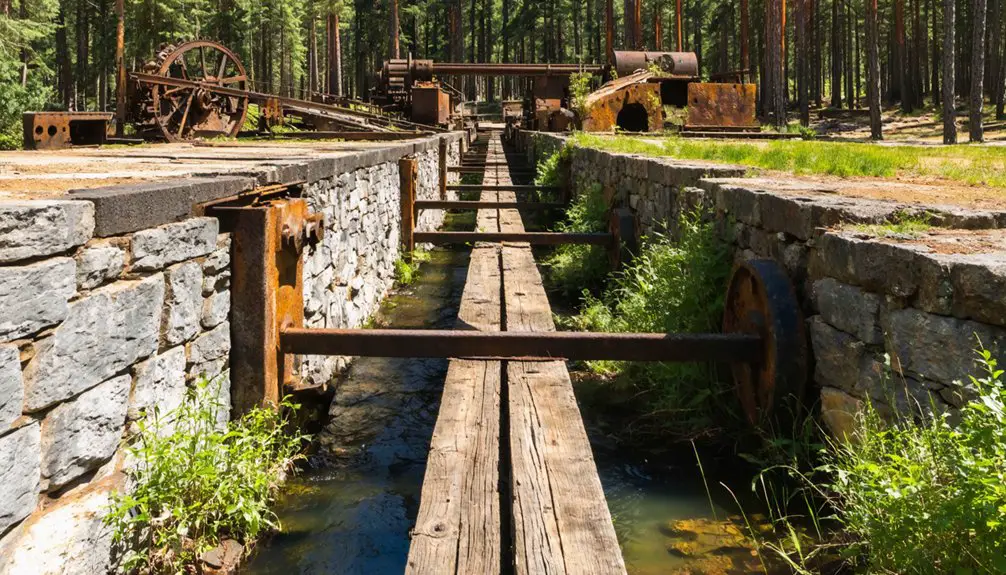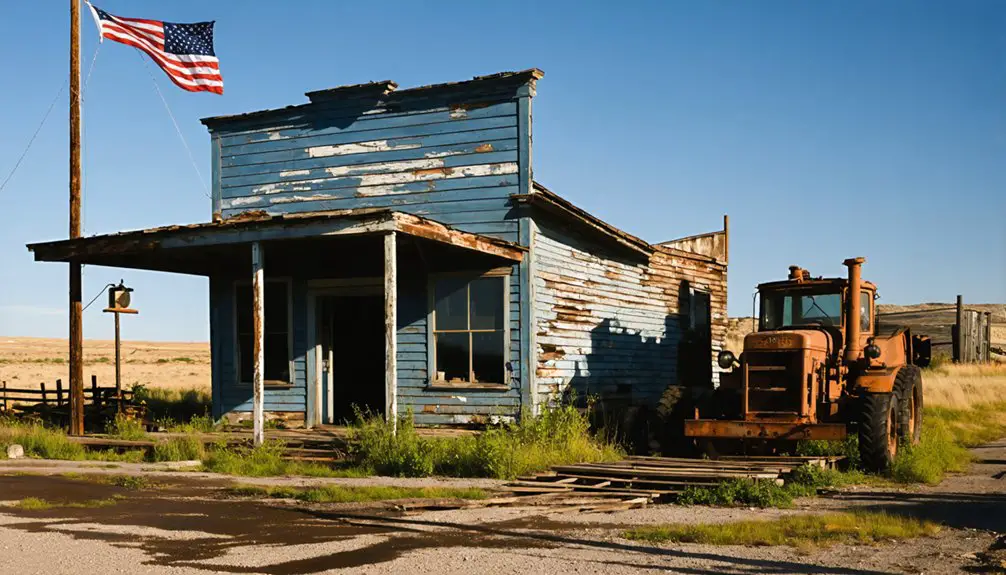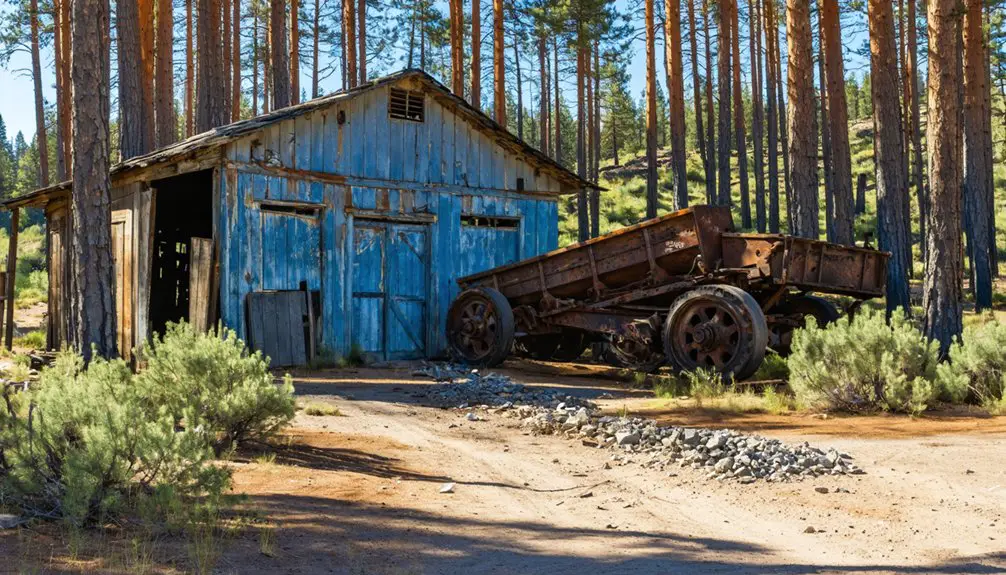You’ll find Placer’s ghost town legacy in Josephine County, Oregon, where it first emerged as Tom East settlement in 1885. Originally named after a local miner, it became Placer in 1894 when the post office opened, reflecting the area’s abundant placer mines. The town flourished with hotels, stores, and saloons during its golden era, supported by diverse mining operations. After the mines depleted and the post office closed in 1924, this once-bustling hub holds countless untold stories of Oregon’s mining past.
Key Takeaways
- Originally named Tom East, Placer was established in 1885 as a mining settlement at the junction of Tom East Creek and Grave Creek.
- The town flourished during the Columbia placer mine boom, featuring hotels, stores, saloons, and diverse mining communities including Chinese workers.
- Placer mining operations evolved from basic panning to sophisticated hydraulic mining, supporting the town’s growth as a commercial hub.
- The post office closure in 1917 marked the beginning of Placer’s decline, with depleted gold deposits causing miners and families to leave.
- By 1927, gold production fell below $100,000, and despite attempts at dredging, Placer eventually became a ghost town.
The Origins of Tom East Settlement
As gold discoveries sparked settlement across Oregon in the 1860s, the area that would become Placer emerged in 1885 as an informal mining camp known as Tom East settlement.
Oregon’s gold rush of the 1860s transformed Tom East settlement from wilderness into a bustling mining camp called Placer.
You’ll find it nestled at the junction of Tom East Creek and Grave Creek in Josephine County, where miners extracted placer gold using traditional techniques like rockers and shovels.
The settlement’s cultural diversity reflected the broader patterns of Oregon’s mining towns, drawing Americans, Europeans, Mexicans, African Americans, and Chinese miners. Early settlers established their own mining town laws to maintain order and regulate claim disputes.
While facing economic challenges and occasional lawlessness, the community established essential infrastructure including stores, a hotel, and a school. The area was officially platted in 1898 by pioneer landowner L.M. Browning.
From Tom East to Placer: A Name’s Evolution
The evolution of Placer’s name reflects the town’s deep connection to Oregon’s mining heritage.
You’ll find the settlement’s historical relevance began when it was informally called Tom East, honoring a local Oregon miner. The name’s significance shifted in 1894 when the Post Office Department officially established it as Placer, directly referencing the area’s abundant placer mines. Similar to Galena, Grant County, the town’s name was inspired by the mining activities in the region.
While Tom East’s legacy lives on through local geographic features like Tom East Creek, the change to Placer proved strategically beneficial. Newell Fillmore Inman initiated this transformation when he applied for the post office in 1893.
The new name coincided with the town’s expansion during the Columbia placer mine boom and helped establish its identity as a mining hub. This naming decision supported Placer’s growth into a bustling community with hotels, stores, and saloons, cementing its role as an essential stop on the regional stagecoach route.
Mining Operations and Economic Growth
You’ll find that Placer’s gold mining operations evolved from basic hand placering in the 1880s to more sophisticated hydraulic mining and dredging methods by the early 1900s.
Chinese miners established a considerable presence in the region, with one hundred miners working at the Two Dragon Camp during peak operations.
Similar to the successful Sterling hydraulic mine that produced an estimated $3 million in early production, Placer’s operations demonstrated the profitability of advanced mining techniques in Oregon.
The Columbia placer mine anchored the town’s early development, while the rich Greenback Quartz Mine soon emerged as another significant producer in the district.
These operations attracted waves of miners and supporting businesses, transforming Placer from a simple mining camp into a bustling commercial hub with hotels, stores, and saloons.
Placer Mining Methods
Four primary placer mining methods transformed Oregon’s gold mining operations during the late 19th century: panning, rocker boxes, sluicing, and hydraulic mining.
If you’re interested in understanding how these gold panning techniques evolved, here’s how each method improved mining efficiency:
- Basic panning involved swirling gold-bearing sediments in a pan, letting water wash away lighter materials.
- Rocker boxes increased productivity with perforated plates and riffles to trap more gold.
- Sluice boxes created longer channels with strategic riffles, processing larger volumes of material.
- Hydraulic mining innovations revolutionized operations by using high-pressure water jets to blast hillsides.
Chinese miners made significant contributions by using wing dam systems to divert river flows for more effective gold extraction.
These methods required increasingly complex water management systems, with miners constructing reservoirs and extensive ditch networks spanning miles to guarantee consistent water supply for their operations.
The most successful hydraulic mining operations, like those run by Gin Lin, yielded over $2 million in gold from the Applegate River region.
Greenback Mine Impact
Since its establishment in 1897 by Len Browning and Edward Hannum, Greenback Mine rapidly emerged as Oregon’s richest mine per feet of tunnel, transforming the region’s economic landscape.
You’ll find the mine’s influence sparked remarkable growth in Placer, where hotels, stores, and saloons flourished to serve the mining community.
After William Brevoot’s purchase in 1902, he founded the town of Greenback specifically to support mining operations. The economic resurgence brought stagecoach lines connecting New Leland to Greenback, intensifying trade and transport. The town’s name reflected the popular Greenback currency used throughout the region. The mine continued to yield valuable gold and silver deposits until its later years.
However, classic ghost town dynamics took hold as mining activity declined. By 1908, Greenback’s post office closed, followed by Placer’s in 1924.
Today, both communities stand as ghost towns, evidence of the boom-and-bust cycle of frontier mining ventures.
Daily Life in a Thriving Mining Hub
The clanking of mining tools and rush of hydraulic water echoed through Placer’s diverse mining community, where white Americans worked alongside Mexican, African American, and Chinese miners in the pursuit of gold.
Community interactions centered around saloons and community halls after long days of physically demanding work moving up to 800 cubic yards of soil.
Your daily life in this thriving hub would have included:
- Living in either a simple tent or wooden cabin, depending on your status and permanence
- Relying on pack animals and small gardens for essential supplies
- Working with various mining techniques from basic panning to complex hydraulic operations
- Steering through cultural influences and social tensions, particularly surrounding Chinese miners who faced discrimination despite their specialized skills
The Town’s Golden Era Infrastructure

During its golden era, Placer boasted a robust infrastructure that served both miners and travelers alike.
You’d find two hotels catering to the constant flow of visitors, while three saloons made the town a vibrant social hub, especially since nearby Greenback prohibited alcohol. These hospitality venues played a vital role in the local economy.
The town’s commercial services included two variety stores stocking mining supplies and everyday necessities. A local newspaper kept residents informed, while the post office, established in 1893, connected the community to the outside world.
Water infrastructure supported innovative hydraulic mining operations, with pipelines feeding the “giants” used in gold extraction. The stagecoach line made Placer an important transit point between New Leland and the Greenback Mine, facilitating trade and passenger movement.
Transportation and Regional Connections
Located northeast of Grants Pass in Josephine County, Placer once relied heavily on a network of transportation routes that connected it to regional mining and commerce centers.
You’ll find its rich transportation history reflected in these key developments:
- Early railroad networks supported mining operations, enabling efficient shipment of ore and supplies through the region.
- The shift from steam to diesel trains marked the beginning of declining rail connectivity.
- The rise of automobiles and highway systems diverted traffic from smaller mining towns.
- Modern transportation challenges have left Placer largely disconnected, requiring four-wheel-drive vehicles for access.
Today, regional isolation defines Placer’s accessibility.
While nearby communities thrive along Interstate 5, just four miles west, you’ll find this ghost town nestled among unmaintained roads and poor signage, a reflection of how transportation evolution shaped its fate.
The Gradual Decline and Abandonment

The eventual closure of Placer’s post office in 1917 marked a critical turning point in the town’s decline, as you’d find this service was often the last official presence in many mining communities.
You’ll notice that mining activity had already begun slowing considerably by the early 1900s, as the easily accessible placer deposits were depleted and more challenging lode mining proved less profitable.
The town’s population dwindled steadily throughout this period, with families departing one by one until the last residents finally abandoned their homes, leaving Placer to join the ranks of Oregon’s ghost towns.
Post Office Closure Impact
When Placer’s post office closed its doors in 1924, the town’s gradual transformation into a ghost town accelerated dramatically. The loss of postal service dealt a severe blow to both commerce and community life, as the post office had served as a crucial community hub for three decades.
You’ll understand the closure’s devastating effects through these critical impacts:
- Businesses couldn’t maintain reliable communication for orders and correspondence.
- Stagecoach routes reduced service, isolating the town from essential transport links.
- Daily social interactions diminished as residents lost their central gathering place.
- New settlers and investors avoided the town due to lack of basic postal infrastructure.
Without this indispensable service, remaining residents were forced to travel to neighboring towns, weakening Placer’s economic and social fabric until its final abandonment.
Mining Activity Slows Down
As Placer’s once-bustling mining operations faced mounting challenges in the early 1900s, dwindling water supplies and depleted gold deposits signaled the industry’s inevitable decline.
You’d have seen placer mining production plummet, with annual yields falling below $100,000 by 1927. Water scarcity hit particularly hard, as hydraulic mining techniques couldn’t function without consistent water sources for sluicing operations.
While miners attempted to adapt through mining technology advances like dredging after 1928, the writing was on the wall.
The rich deposits that had yielded millions in gold during the boom years were largely exhausted. Many miners shifted their focus to quartz lode mining at sites like Greenback and Granite Hill, while others simply abandoned their claims, contributing to Placer’s transformation into a ghost town.
Population Exodus Patterns
Once thriving with optimistic prospectors during its 1860s gold discovery and 1890s establishment, Placer witnessed a relentless population decline that would eventually render it completely abandoned.
The demographic shifts accelerated dramatically after 1942 when the government ordered mine closures during WWII, triggering widespread migration trends toward more accessible towns.
You’ll find four key factors that drove Placer’s exodus:
- Limited medical facilities and harsh climate led to high mortality rates
- Loss of transport links severely reduced supply chain reliability
- Closure of essential services like schools and stores broke down community bonds
- Lack of alternative employment forced families to seek opportunities elsewhere
The town’s remote location and deteriorating infrastructure hastened its transformation into a ghost town, as younger generations sought better prospects in more connected communities.
Legacy in Oregon’s Mining History

The discovery of placer gold deposits in Oregon during the mid-19th century sparked a transformative period in the state’s mining history.
You’ll find evidence of this era’s cultural influences in towns like Baker City and Auburn, which grew from mining camps into established settlements. Early miners used simple tools like pans and rockers before advancing to hydraulic mining technology that dramatically increased gold production.
From simple pans to powerful hydraulics, Oregon’s mining towns evolved alongside the tools that shaped their golden destinies.
Today, you can spot the archaeological findings of this mining legacy through LIDAR technology, revealing historic infrastructure like ditches, reservoirs, and tailings piles.
While the boom eventually faded, placer mining laid the foundation for Oregon’s broader mining industry, contributing to transportation networks and permanent settlements. The practice helped shape Oregon’s economic and demographic landscape, leaving an indelible mark on the state’s development.
Frequently Asked Questions
Are There Any Remaining Buildings Still Standing in Placer Today?
You’ll find several remaining structures preserved today: an 1892 church, the Ruble house from 1892, a shed, post office/store building, and the 1904 general store with historical preservation status.
What Was the Peak Population of Placer During Its Mining Boom?
Like gold dust scattered in a stream, you’ll find the exact peak population’s a mystery, though based on similar mining towns and placer mining techniques, it likely reached between 300-500 people during the 1860s boom.
Did Any Famous Historical Figures Ever Visit or Live in Placer?
You won’t find any nationally famous historical visitors or notable residents in Placer. The town’s key figures were local pioneers like Tom East, L.M. Browning, and Newell Fillmore Inman.
Were There Any Major Crimes or Notable Incidents in Placer’s History?
You won’t find records of major crime incidents or historical conflicts specific to Placer. While nearby mining towns experienced notable violence and robberies, Placer’s documented history focuses mainly on mining activities.
How Much Gold Was Extracted From the Placer Mines in Total?
You’ll find that Baker County’s placer mining yielded over 402,490 ounces in gold between 1880-1899 alone. With improved mining techniques and continued extraction through 1959, the area’s total gold production reached 1,596,500 ounces.
References
- https://www.ijpr.org/show/as-it-was/2015-09-14/town-of-placer-serves-as-mining-center-in-josephine-county
- https://www.deviantart.com/austinsptd1996/journal/Six-Iconic-Ghost-Towns-Within-Oregon-1109696435
- https://www.oregonencyclopedia.org/articles/ghost_towns_illinois_river_valley/
- https://www.historynet.com/golden-oregon-ghost-town/
- https://westernmininghistory.com/towns/oregon/golden/
- http://www.webtrail.com/history/placer.shtml
- https://www.oregonhistoryproject.org/narratives/the-world-rushed-in-northeastern-oregon/bonanza-times-and-after/law-order-and-diversity/
- https://www.oregon.gov/dogami/milo/archive/HistoricalSociety/Josephine/MineralWealth.pdf
- https://truwe.sohs.org/files/miningnotesd.html
- https://en.wikipedia.org/wiki/Placer



